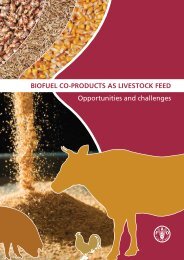ExtensionExtraExEx 2035August 2002Animal &RangeSciencesCOLLEGE OF AGRICULTURE & BIOLOGICAL SCIENCES / SOUTH DAKOTA STATE UNIVERSITY / USDAUse of <strong>Distillers</strong> Dried <strong>Grains</strong> With Solubles(DDGS) in Swine DietsBob Thaler, Extension swine specialistMore and more ethanol co-products are available for livestockfeed because of the rapid growth of the ethanolindustry in South Dakota. The three main co-products are<strong>Distillers</strong> <strong>Grains</strong>, Solubles, and <strong>Distillers</strong> <strong>Grains</strong> withSolubles, and they can be either “wet” or “dried” dependingon the manufacturing process.Since, in the U.S., on-farm feed mixing and swine feedingsystems are almost exclusively designed for dry feed, wedeal here only with the dried products. All ethanol plantsin South Dakota mainly produce <strong>Distillers</strong> Dried <strong>Grains</strong>with Solubles (DDGS), limiting our discussion further toonly DDGS as a feed ingredient for swine.DDGSCorn is two thirds starch, and during the fermentation anddistillation processes, the starch is converted to ethanol.One bushel of corn produces approximately 2.6 gallons ofethanol, 17 lbs of CO 2 , and a wet spent-mash.The wet mash goes through a series of centrifuges, evaporators,and presses to produce Solubles (liquid) and<strong>Distillers</strong> <strong>Grains</strong> (semi-dry). The Solubles and <strong>Distillers</strong><strong>Grains</strong> are then blended and dried to produce 17 lbs ofDDGS from the same bushel of corn.DDGS is a co-product, and like all co-products (soybeanmeal, meat and bone meal, sunflower meal), it can varygreatly in nutrient concentrations. Ranges of nutrient concentrationsand physical characteristics from nine DDGSsamples are given here:Dry matter 87 - 93%Crude protein 23 - 29%Crude fat 3 - 12%Lysine .59 - .89%Color light golden to dark brownSmell sweet to smoky or burntGrowth trials conducted with the nine different DDGSsources demonstrated large differences in gain, feedintake, and feed efficiency, depending on the source ofDDGS in the diet. Therefore, DDGS quality has a considerable—andvariable—impact on livestock performance.Why these differences in nutrient concentrations? Thereare several reasons.First of all, nutrient variability of the corn used has a dramaticimpact on the variability of DDGS. Since the starchin corn is converted to ethanol and removed, the remainingnutrients in corn are concentrated and roughly tripledin the resulting DDGS.For example, if a load of corn contains .26% lysine, theresulting DDGS will likely contain .78 % lysine.However, if a lower lysine corn (.23% lysine) is used, theresulting DDGS will contain only .69% lysine. The same
ule applies for the concentrations of all the other nutrients(fat, fiber, protein, phosphorus, etc.)The second factor to have a major impact on DDGS nutrientconcentrations is processing methods. Type of yeastused, fermenting and distillation efficiency, drying temperatureand time, and amount of solubles blended with thedry material all affect the nutrient concentrations in DDGS.Recent research at the University of Minnesota also hasshown that DDGS from the new-generation ethanol plantsin South Dakota and Minnesota has higher nutrient concentrationsthan DDGS from traditional ethanol plants.Table 1 shows the nutrient composition of traditional and“new generation” DDGS.Table 1. Nutrient composition of two sources of DDGS(as-fed basis).Traditional SD/MNNutrient DDGS DDGSCrude Protein 27.7% 26.8%Total lysine .62% .74%Digestible lysine .29% .39Crude fat 8.4% 9.7%Crude fiber 9.1% 7.8%Calcium .20% .05%Total phosphorus .77% .79%Digestible phosphorus .59% .71%Metabolizable energy, kcal/lb 1282 1633Table 1 shows large differences in nutrient concentrationsfor the processing methods, especially for two of the mostcritical nutrients: digestible lysine (34.5%) and digestiblephosphorus (20.3%). The question then becomes “Whatvalues do I use when formulating swine rations?”The best answer is to properly sample each load of DDGSyou get and analyze for lysine and phosphorus. Thenmultiply those values by their digestibility coefficients(lysine = .53; phosphorus = .90) to get the amountdigestible of each nutrient.For example, if a sample of DDGS contained .80% totallysine and .78 total phosphorus, you’d multiply .80% times.53 to get a digestible lysine value of .42%. Then, multiply.78% by .90 to get a digestible phosphorus concentrationof .702%. These are the values you need to use when balancingswine rations.If analyzing each load of DDGS is not feasible, the nextbest thing to do is to visit the plant you purchased the2DDGS from and find out the nutrient range of its productover the last 6 months. To avoid a potential nutrient deficiency,it is then best to select a value at the lower end ofeach range to use when formulating.If that data is not available, consider changing suppliers oruse the values for traditional DDGS.Another method to reduce nutrient variation is to develop aDDGS specification sheet for nutrient levels and physicalcharacteristics, and then only buy DDGS from plants thatwill guarantee meeting those specifications. However, youare responsible for periodic testing to ensure your specificationsare being met. Table 2 is one example of such asheet.Table 2. Specifications for DDGS for swine diets.Moisture maximum 12%Crude protein minimum 26.5%Crude fat minimum 10%Crude fiber maximum 7.5%Color goldenSmell fresh, fermented, pleasant cereal odorBulk density 34 – 37 lb/cubic footParticle size coarse = 10% maximum on a 2000-mesh screenfine = 15% maximum on a 600-meshscreen and panMycotoxinsMycotoxins are produced by molds either in the field orduring storage. They can severely impact pig and sow performance.While there are many different mycotoxins,zearalenone and vomitoxin (DON) are the main ones ofconcern for South Dakota pork producers.Unfortunately, the fermentation process does not destroymycotoxins. In fact, just as it does for lysine and othernutrients, it concentrates the mycotoxins threefold. If corncontaining 1 ppm zearalenone is delivered to an ethanolplant, the resulting DDGS will contain 3 ppm zearalenone.Since the maximum inclusion rate of both mycotoxins is1 ppm in the total diet, it does not take a large amount ofmycotoxins to cause problems, especially for sows.This is more of a problem if the ethanol plant is purchasingdamaged grains or if it has been a year in which there hasbeen a mycotoxin problem in the corn in the field.
















